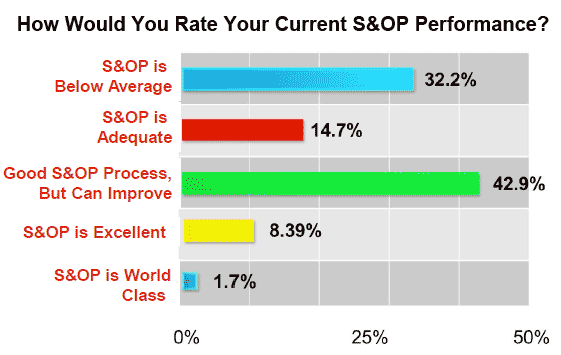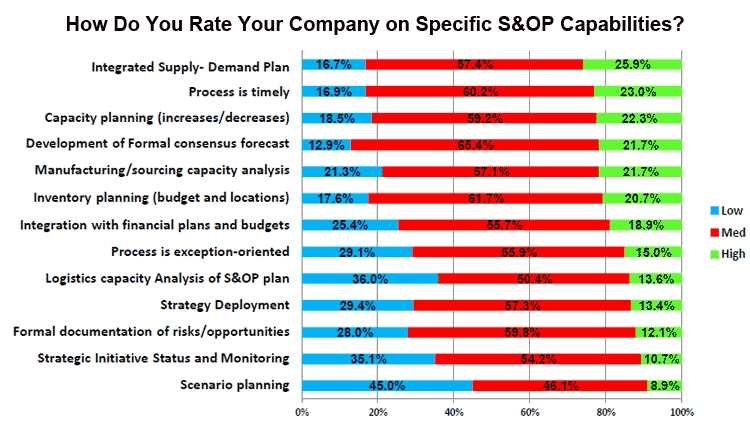|
Sales and Operations Planning - S&OP - one of the most interesting and at the same times curious topics in the supply chain today.
Developed in the 1980s by consultant Oliver Wight (who was also instrumental in the creation of Manufacturing Resources Planning (MRP II), S&OP as most know started out as a technique to balance supply and demand, but has since evolved to be more about aligning business strategies and execution across the company.
Gilmore Says: |
 Getting deep organizational alignment on plans and execution isn't enough any more - companies must use S&OP to respond to continual changes in markets, conditions and opportunities faster than the other guy. Getting deep organizational alignment on plans and execution isn't enough any more - companies must use S&OP to respond to continual changes in markets, conditions and opportunities faster than the other guy. 

Click Here to See
Reader Feedback |
It has more recently evolved to also focus on tying those aligned strategies and execution to the company's financial goals and budgets, and with that progression the concept of "Integrated Business Planning" (IBP) was born, though still a minority of companies use term versus traditional S&OP nomenclature.
When I was on the true corporate side of things in the early to mid-1990s at divisions of NCR and Pitney Bowes, I never heard the term S&OP a single time, and there was no process even remotely similar to today's traditional S&OP monthly planning cycle. A lot has sure changed since then, with a clear preponderance of larger companies at least doing some form of S&OP, and many medium-sized firms as well.
But how many of those companies are doing it well? That is the question many have been asking for the past 10 years. I would here draw some parallels with Lean. It is hard to find a manufacturing company (as well as many other types of firms) that doesn't use Lean/Lean Six Sigma in some form. But it is a real continuum from there, from companies just starting out at one end to the relatively few true pros (Toyota, Donaher, etc.), with the mass somewhere between those extremes: getting benefits from Lean for sure, but somehow failing to full reap the potential.
That despite the fact that the Lean "playbook" is hardly a secret. It's out there for all to learn. Call Toyota, it will be happy to have you come in. Yet despite that clear path to Lean success, it takes many companies a very long time to get there, while many others simply hit a plateau.
I think it is much the same with S&OP. Again, there are no end of playbooks out there for how S&OP should work, what the steps of the process are, etc. I might argue we almost have a glut of such insight. The path is clear, with many experts to show companies the way, but for whatever series of reasons, many companies struggle to reach high levels of S&OP performance.
S&OP might be slightly different than Lean, however, in that "state of the art" concepts and processes I think are continuing to evolve more so than they are with Lean. That would include areas such the evolution to an IBP-type process, as well as more and more sophisticated analyses and scenario planning exercises that S&OP leaders are adding to their standard processes. The basics remain the same, while the state of the art continues to advance, if that makes sense.
All that as a backdrop to the release of a new benchmark report on the state of S&OP from our research arm, Chief Supply Chain Officer Insights, based in part of a survey of almost 400 respondents from supply chain, finance, and other disciplines. S&OP is as much studied as any topic, but I believe this report takes it further than any to date.
The report is presented in a nice, easy to digest "infographic" style, full of graphs and concise commentary, no big pages of text to wade through. It can be downloaded here: Closing the Gaps in S&OP. There is also a resources page that goes along with the report, with SCDigest articles on S&OP, examples charts from the report, other white papers, etc,: Closing the Gaps in S&OP resources page.
The results supported the initial hypothesis that there are important gaps between where companies are or believe they are with S&OP versus best current practices - and that closing those gaps will lead to significant improvements in operational and financial performance.
A quick note of the research: I felt like I knew my way around S&OP well enough, but when an early version of the survey tool was reviewed by the experts at Oliver Wight consulting and Oracle, and when their significant improvements to the survey came back, I realized I had an awful lot to learn. Like many companies, I too had hit a plateau in my S&OP performance.
So let's just quickly review some of the responses, starting with a basic question of where companies believe they are at in terms of S&OP effectiveness.

This came out not far from where I would have predicted, with the preponderance (43%) believing they are pretty good at S&OP, but could improve. Fair enough. But that leaves even more (about 47%) saying that their S&OP is below average or just "adequate," while only 10% think they are "excellent" or "world class."
And here is where the "gaps" come in. The graphic below summarizes how companies rate themselves on a number of S&OP capabilities, from basic to more advanced.

As can be seen, small percentages of companies, for example, rated themselves as having "high performance" in any of these areas, down to just 8.9% who feel that way about their scenario planning capabilities. This may sound harsh, but in fact many companies who believe they are "good but could improve" may in fact just be "adequate" at S&OP versus where leaders are today.
I am as always out of space, but of course there is much, much more here, and the report in effect lays out the type of capabilities and processes leaders are using, from which companies can develop an S&OP improvement roadmap.
In the end, that will in part involve moving to a culture of "dynamic strategy management." Getting deep organizational alignment on plans and execution isn't enough any more - companies must use S&OP to respond to continual changes in markets, conditions and opportunities faster than the other guy.
That's simply how you win today.
Do you believe there are still large gaps between current S&OP performance versus the potential? Why is that? Let us know your thoughts at the Feedback section
below.
|